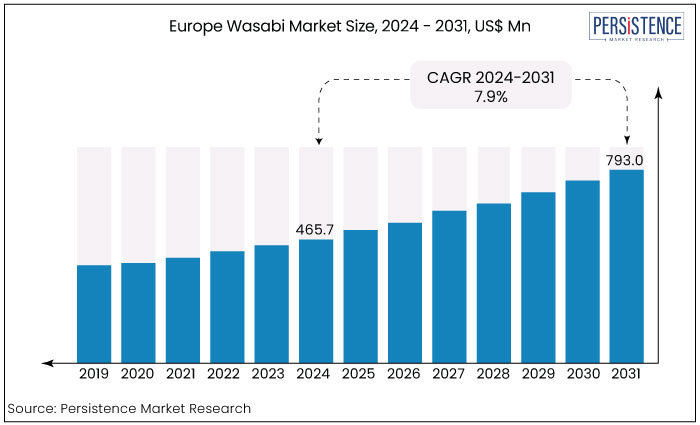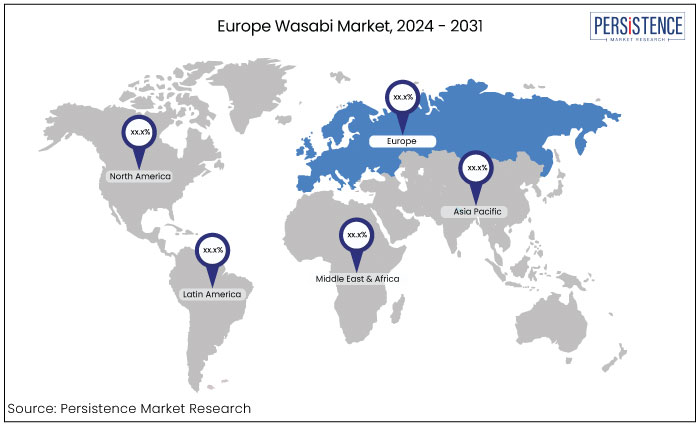Industry: Food and Beverages
Published Date: September-2024
Format: PPT*, PDF, EXCEL
Delivery Timelines: Contact Sales
Number of Pages: 165
Report ID: PMRREP34823
The Europe wasabi market is estimated to increase from US$465.7 Mn in 2024 to US$793.0 Mn by 2031. The market is projected to record a CAGR of 7.9% during the forecast period from 2024 to 2031.

Key Highlights of the Market
|
Market Attributes |
Key Insights |
|
Europe Wasabi Market Size (2024E) |
US$465.7 Mn |
|
Projected Market Value (2031F) |
US$793.0 Mn |
|
Global Market Growth Rate (CAGR 2024 to 2031) |
7.9% |
|
Historical Market Growth Rate (CAGR 2019 to 2023) |
6.4% |
|
Category |
Market Share in 2024 |
|
Product Type- Paste |
45.5% |
Wasabi paste is projected to be the largest contributor in the Europe wasabi market, accounting for 45.5% of the total market share. The popularity of wasabi paste is driven by its convenience, ease of use, and wide availability making it a preferred choice for both restaurants and consumers. As a ready-to-use product, wasabi paste eliminates the need for preparation and offers a consistent flavor profile, which is crucial for foodservice establishments that need to ensure uniform taste in their dishes.
Wasabi paste aligns well with the growing trend of authentic Japanese cuisine across Europe. It is commonly used in sushi, sashimi, and various other dishes, increasing its demand among both chefs and home cooks. The rise in Japanese restaurants and fusion cuisine has also played a significant role in boosting the consumption of wasabi paste, solidifying its position as the dominant product type in the market.
|
Category |
Market Share in 2024 |
|
Form - Processed |
51.3% |
Processed wasabi is projected to be the largest contributor by form, accounting for 51.3% of the market share. The dominance of processed wasabi including pastes, powders, and ready-to-use forms is attributed to its convenience, and ease of transportation making it more accessible to a wide range of consumers.
Processed wasabi products cater to the growing demand from restaurants, supermarkets, and food manufacturers seeking a consistent and readily available supply of the ingredient. Moreover, these products allow for easy storage and use compared to fresh, raw wasabi, which is highly perishable and loses its potency quickly after preparation.
As the market for Japanese cuisine continues to expand, processed wasabi is expected to maintain its position as the leading form due to its practicality and availability.
|
Category |
Market Share in 2024 |
|
Application - Food & Beverages |
45.8% |
The food and beverage sector continues to dominate the Europe wasabi market maintaining its position as the leading application area. This dominance is primarily driven by the rising popularity of Japanese cuisine such as sushi and sashimi, across Europe.
As consumers become more adventurous and seek authentic dining experiences, restaurants and foodservice providers increasingly rely on wasabi as a key ingredient to deliver genuine flavor profiles. Beyond traditional Japanese dishes, wasabi's versatility has also led to its integration into fusion cuisines, snacks, and condiments, further solidifying its importance in the food and beverage industry.
The growing trend of premium and authentic ingredients in gourmet cooking has elevated wasabi’s profile, especially in high-end restaurants and specialty stores. This robust demand from the food and beverage sector ensures that it remains the dominant application, contributing significantly to market growth.
The Europe wasabi market has witnessed increasing recognition due to the growing popularity of Japanese cuisine particularly in metropolitan areas with a high demand for authentic culinary experiences. Wasabi, a traditionally Japanese plant, is known for its unique, pungent flavor and has become a highly sought-after ingredient in sushi and fine dining restaurants across Europe.
The market for genuine wasabi is still emerging, as much of the wasabi consumed in Europe historically has been substituted with horseradish-based imitations due to the high cost and limited availability of the real plant.
A key trend shaping the market is the rising consumer preference for authenticity and high-quality ingredients, which has prompted chefs and restaurants to source real wasabi. This shift is driven by increasing awareness among consumers about the differences between imitation and genuine wasabi, with the latter offering superior flavor and culinary appeal.
Advancements in hydroponic farming techniques have allowed European producers to cultivate wasabi domestically, reducing dependency on imports from Japan and enabling more consistent availability.
The health benefits associated with wasabi, including its anti-inflammatory and antibacterial properties have contributed to its growing demand in health-conscious markets. Moving forward, sustainability and innovation in production techniques will remain important trends, as the market strives to meet rising demand without compromising quality.

Europe wasabi market has experienced steady growth over the past decade driven by the increasing popularity of Japanese cuisine particularly sushi, across the region. Historically, the demand for wasabi in Europe was largely met by substitutes such as horseradish mixed with mustard and green coloring due to the scarcity and high cost of genuine wasabi.
As consumers and chefs in Europe became more discerning and sought authentic ingredients to elevate the culinary experience, the demand for real wasabi grew significantly. The cultivation of genuine wasabi outside Japan began expanding to meet this demand.
Innovative growing techniques such as hydroponics were developed in countries like the United Kingdom, the Netherlands, and parts of Southern Europe. These advancements allowed for small-scale domestic production, helping to reduce reliance on imports from Japan.
Europe wasabi market is poised for further growth as consumers continue to prioritize high-quality, authentic ingredients. The increasing presence of premium Japanese restaurants and a broader awareness of the health benefits associated with wasabi consumption will fuel demand.
European Culinary Shift Toward Genuine Wasabi
As consumers and chefs in Europe develop a deep appreciation for traditional Japanese dishes, there is an increasing focus on using authentic ingredients to enhance the dining experience.
Unlike the commonly used horseradish-based wasabi substitutes, real wasabi provides a distinct flavor and freshness that discerning diners and high-end restaurants are seeking. This shift in consumer preference towards quality and authenticity is driving demand for genuine wasabi, especially among upscale eateries that aim to offer an authentic Japanese culinary experience.
European chefs inspired by traditional Japanese culinary techniques are keen to source genuine wasabi to complement their dishes. The surge in interest in washoku, Japanese cuisine recognized as a UNESCO intangible cultural heritage, further fuels the demand for authentic ingredients.
As more Japanese restaurants open across Europe, with chefs and culinary professionals seeking to recreate true Japanese flavors, the market for high-quality, real wasabi continues to grow. This increasing preference for traditional, premium ingredients positions wasabi as a key driver in the evolving European culinary landscape, offering significant growth opportunities for wasabi producers catering to this demand.
Health Benefits of Wasabi
With a rising demand for foods that offer functional health benefits, wasabi is emerging not just as a culinary staple but also as a vegetable with impressive health advantages. Its high concentration of isothiocyanates (ITCs) lends it antibacterial properties effective against common foodborne pathogens like Escherichia coli and Staphylococcus aureus. Also, preliminary studies suggest that wasabi may possess anti-inflammatory effects and could help combat peptic ulcers caused by Helicobacter pylori.
Potential anticancer properties of wasabi related to the inhibition of harmful compounds like acrylamide during cooking add to its allure for health-conscious consumers. This trend is reinforced by the growing popularity of authentic Japanese cuisine, which drives the demand for high-quality ingredients that align with wellness goals. As awareness of wasabi’s health benefits continues to expand, its market presence in Europe is likely to increase positioning health and wellness as a key driver for its growth.
Climatic Obstacles
The plant, which thrives in cool, humid environments typically found in Japan's mountainous river valleys struggles to adapt to the varied climate conditions across Europe. Factors such as temperature fluctuations, inadequate humidity, and susceptibility to frost during colder months can hinder successful cultivation.
The semi-aquatic nature of wasabi requires precise watering and soil conditions making it challenging for both commercial growers and home gardeners to achieve optimal growing conditions. The need for consistent moisture without waterlogging adds another layer of complexity, as does the requirement for shade or semi-shade to prevent direct sunlight exposure.
Cultivation hurdles can deter potential growers, thereby limiting the supply of authentic wasabi in the market. As a result, the difficulty in growing wasabi in European climates serves as a restraint potentially impacting the availability and price of this sought-after condiment in the culinary landscape.
Influence of Competitive Alternatives
The Europe wasabi market faces significant challenges due to competition from various substitutes that can replicate or mimic the distinctive flavor profile of authentic wasabi. Ingredients such as horseradish, which shares a similar botanical lineage, provide a cost-effective alternative for consumers seeking a spicy condiment.
Other substitutes like ginger, mustard, and various types of chili peppers can easily replace wasabi in recipes particularly in dishes like sushi and noodles. These alternatives are often more readily available and affordable making them appealing to both consumers and chefs.
The presence of substitutes not only affects consumer choices but also puts pressure on wasabi producers to justify higher prices associated with authentic wasabi. As a result, the growth potential of the European wasabi market is constrained, as consumers may opt for these readily accessible substitutes rather than seeking out the authentic product. This competition necessitates strategic marketing and efforts to educate consumers about the unique qualities and culinary benefits of real wasabi.
Hydroponic and Controlled Environment Agriculture
Hydroponic and controlled environment agriculture (CEA) represent a significant opportunity for the wasabi market particularly in regions where traditional cultivation is challenging. By utilizing hydroponic systems, farmers can create optimal growing conditions that mimic the cool, moist environments where wasabi naturally thrives. This innovative approach not only allows for year-round production, but also maximizes space efficiency making it ideal for urban farming initiatives.
CEA enables precise control over key growth factors such as temperature, light, and nutrient delivery, which are crucial for the successful cultivation of wasabi. As the demand for fresh, high-quality wasabi continues to rise, hydroponic systems can provide a sustainable solution that minimizes the risks of pests and diseases commonly associated with soil cultivation. This method also conserves water by recycling nutrient solutions, aligning with environmental sustainability goals.
By embracing hydroponic and controlled environment techniques, producers can tap into a lucrative market while addressing the increasing consumer preference for locally sourced, fresh ingredients.
Growing Network of High-End Restaurants and Specialty Food Retailers
The growing network of high-end restaurants and specialty food retailers in Europe represents a significant opportunity for wasabi growers to penetrate a niche market that values fresh, authentic ingredients. With an increasing focus on unique dining experiences, chefs are continually seeking high-quality products to elevate their menus. For instance, a partnership with upscale restaurants or gourmet food retailers can create a steady demand for premium wasabi, allowing growers to capitalize on the willingness of these establishments to pay a premium for authentic flavor.
Collaborations with renowned chefs can also enhance brand visibility and credibility, further establishing wasabi as a sought-after ingredient in high-end culinary applications. By strategically positioning themselves within this evolving market, wasabi producers can leverage the trend towards quality dining and specialty foods to drive growth and profitability.
The Europe wasabi market is experiencing substantial expansion as highlighted in recent market analyses reflecting its vibrant and evolving landscape. To take advantage of this burgeoning market, stakeholders are implementing innovative practices and harnessing cutting-edge technologies to discover new growth avenues.
Leading industry participants are adopting essential strategies, including portfolio diversification, regional market expansion, and increased investments in research and development. By pursuing these initiatives, market players seek to maintain competitiveness, respond to shifting consumer preferences, and propel further advancement within the sector.
Recent Development in the Europe Wasabi Market
|
Attributes |
Details |
|
Forecast Period |
2024 to 2031 |
|
Historical Data Available for |
2019 to 2023 |
|
Market Analysis |
US$ Million for Value |
|
Key Countries Covered |
|
|
Key Market Segments Covered |
|
|
Key Companies Profiled |
|
|
Report Coverage |
|
|
Customization & Pricing |
Available upon request |
By Product Type
By Form
By Application
By Distribution Channel
By Country
To know more about delivery timeline for this report Contact Sales

The market is estimated to value at US$793.0 Mn by 2031.
Increasing demand for authentic Japanese cuisine, health and wellness trend drives the market forward.
The Watercress Company, KINJIRUSHI CO., Ltd, Sung Ghing Biotech Development Co, LTD., S&B FOODS INC., Real Wasabi are some of the leading industry players in the market.
The market is projected to record a CAGR of 7.9% during the forecast period from 2024 to 2031.
A prominent opportunity lies in the Wasabi industry is the hydroponics and controlled environment agriculture.